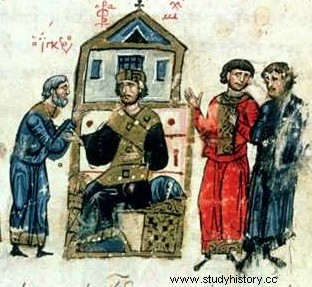 With its capital built on the ancient city of Byzantium, the Byzantine Empire was the direct descendant of the Eastern Roman Empire . It lasted nearly a thousand years, until Constantinople was taken. by the Turks in 1453. After the fall of Rome in 476, a major break in Roman history, it is accepted by historians that we speak of the Byzantine Empire for the period after this date. The first Byzantine emperors attempted to reconstitute the geographical borders of the ancient Roman Empire, reconquering the territories lost to the west. Many military campaigns are carried out in the 6th century, during the reign of Justinian. However, these conquests are short-lived and the empire gradually shrinks under the influence of Arab and Slavic invasions.
With its capital built on the ancient city of Byzantium, the Byzantine Empire was the direct descendant of the Eastern Roman Empire . It lasted nearly a thousand years, until Constantinople was taken. by the Turks in 1453. After the fall of Rome in 476, a major break in Roman history, it is accepted by historians that we speak of the Byzantine Empire for the period after this date. The first Byzantine emperors attempted to reconstitute the geographical borders of the ancient Roman Empire, reconquering the territories lost to the west. Many military campaigns are carried out in the 6th century, during the reign of Justinian. However, these conquests are short-lived and the empire gradually shrinks under the influence of Arab and Slavic invasions.
The Roman Empire survives in the east
In 324, Constantine the Great (306-337) chooses Byzantium , a Greek port located on the left bank of the Bosphorus, the thin strait separating Turkey from Europe, to make it the new capital of the East. He renamed the city Constantinople . The exchanges between the Black Sea and the Mediterranean Sea being excellent, the trade knew a great expansion and the city developed quickly. It was surrounded by the sea; and solidly defended inwards by a fortified wall which was built in the 5th century. During his reign, Constantine established a pattern of harmony between the Church and the imperial authorities, which persisted throughout the history of the Empire. It creates a durable monetary system, based on the solidus of gold which remained in circulation until the middle of the 11th century).
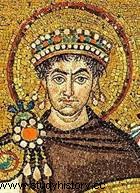 The division between East and West is only final after the death of Theodosius I in 395. The emperor bequeaths the government to his two sons, Arcadius and Honorius, who have the title of Augustus. Thus the Western Roman Empire (western part) fell to Honorius, while the Eastern Roman Empire (eastern part, covering southeastern Europe, southwestern Asia and northern Africa) goes to Arcadius. Succeeding Arcadius, the Eastern Roman emperors of the Theodosian dynasty thus governed from the “Second Rome”, Constantinople. Although after the fall of Rome (476) and the collapse of the Western Roman Empire, only the Eastern Roman Empire remained. , the idea and the dream of unity still remain, both among the rulers and among the subjects of the Byzantine Empire.
The division between East and West is only final after the death of Theodosius I in 395. The emperor bequeaths the government to his two sons, Arcadius and Honorius, who have the title of Augustus. Thus the Western Roman Empire (western part) fell to Honorius, while the Eastern Roman Empire (eastern part, covering southeastern Europe, southwestern Asia and northern Africa) goes to Arcadius. Succeeding Arcadius, the Eastern Roman emperors of the Theodosian dynasty thus governed from the “Second Rome”, Constantinople. Although after the fall of Rome (476) and the collapse of the Western Roman Empire, only the Eastern Roman Empire remained. , the idea and the dream of unity still remain, both among the rulers and among the subjects of the Byzantine Empire.
The eastern empire, richer and more populous than the western one, had more resources to resist the Germanic invasions. Justinian I (emperor from 527 to 565) tries to reconstruct the geographical borders of the Roman Empire. With the help of two brilliant generals, Bélisaire and Narses, the emperor undertook to reconquer, between 534 and 565, North Africa, southern Italy, Sicily, Sardinia and part of Spain.
This military effort is accompanied, internally, by a considerable legislative work, the Justinian Code (529), a sum of Roman law that inscribes the Roman Empire in East in continuity with ancient Rome. Justinian's code is subsequently used by all Byzantine emperors (and also influenced the laws of many European countries).
At the end of the 6th century, the attacks of the Slavs and Avars living north of the Danube, weakened the empire. In the East, the Sassanid Persians occupied Syria, Palestine and Egypt, before being defeated in 627 by Emperor Heraclius (610-641). He saved the Empire and introduced the reforms the country needed.
The religion of the Byzantine Empire
Since Emperor Constantine the Great converted in 312, Christianity has gradually become the accepted religion of the empire. Seeking to show the world their power, the Byzantine emperors ordered the construction of splendid buildings throughout their empire, and in particular in the capital Constantinople. The finest example of Byzantine art is the Saint Sophia Cathedral in Constantinople (Saint Sophia being a translation of Hagia Sophia, which means "Holy Wisdom"), the true religious center of the empire. Inside, the building is decorated with splendid mosaics, characteristic of Byzantine art.
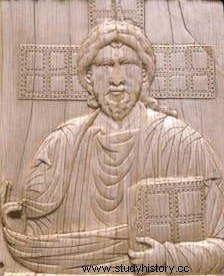 In the Byzantine Empire, paintings depicting Christ or saints were venerated by monks and Christians. Some Byzantine emperors refused this worship of holy images (icons). From 726, a violent quarrel broke out about these holy images; it is iconoclasm. The restoration of the images in 843 marked the victory of the monks:Christian monasteries then multiplied in the Byzantine Empire.
In the Byzantine Empire, paintings depicting Christ or saints were venerated by monks and Christians. Some Byzantine emperors refused this worship of holy images (icons). From 726, a violent quarrel broke out about these holy images; it is iconoclasm. The restoration of the images in 843 marked the victory of the monks:Christian monasteries then multiplied in the Byzantine Empire.
Since the birth of Christianity, Rome has been one of the centers of the Christian church, whose spiritual leader is the Bishop of Rome (later known as Pope); he tries to impose his authority on the other spiritual leaders of the Christian world, in particular the Patriarch of Constantinople. The Patriarch of Constantinople and the Byzantine Christians regularly disagree with the Pope's decisions. These various quarrels between Christians of the East (Constantinople) and of the West (Rome) lead to the schism of 1054. This event, also called the Great Schism, confirms the separation between Christians of the East and of the West, that is- that is, between Orthodox and Catholics.
Byzantine art:religious and contemplative
Byzantine art and architecture developed to glorify both the Christian Church of the East (which became the Orthodox Church) and its emperor (representative of God on Earth). Unlike the Christian Church of the West, whose faithful still venerated the relics of saints at the end of the Middle Ages, the Christian Church of the East was more contemplative, concentrating on the veneration of icons, religious portraits, stylized and often presented from the front.
While Byzantine art continues to exploit its ancient heritage as a source of inspiration and renewal, classical expression is abandoned in favor of the transcendent character of the Orthodox faith. Rather, the artists seek to evoke the spiritual character of the saints. Painters and mosaicists, by avoiding taking a model for their figures, eliminate any suggestion of an actual human form. Thus, the production of statues is totally abandoned after the 5th century. The sculpture is limited, for the most part, to ivory plates (called "diptychs") in low relief, with limited sculptural effects.
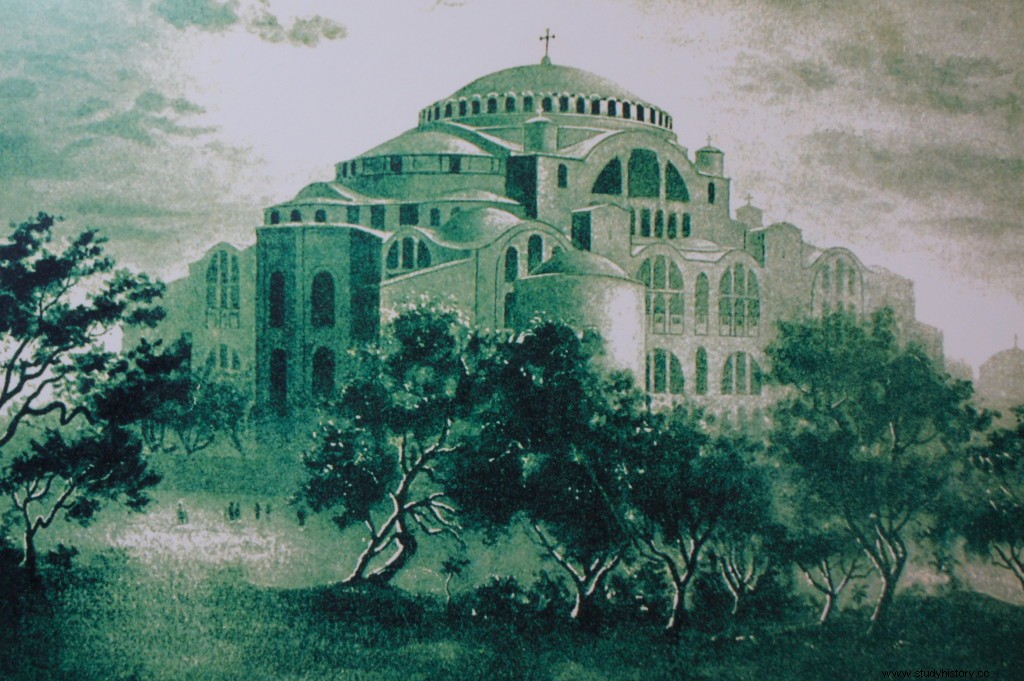 In the fifth century, the art and architecture of the Eastern Roman Empire were still strongly influenced Romano-Christian canons, so that they are more qualified as post-antique than as proto-Byzantine. On the other hand, shortly after 500, the transition between early Christian classicism and the birth of the Byzantine style seemed to take place. The golden age of proto-Byzantine art and architecture coincides with the reign of Justinian the Great (527-565), a great builder and protector of the arts. The finest example of Byzantine art is the Saint Sophia Cathedral in Constantinople (Saint Sophia being a translation of Hagia Sophia, which means "Holy Wisdom"), the true religious center of the empire. Inside, the building is decorated with splendid mosaics, characteristic of Byzantine art.
In the fifth century, the art and architecture of the Eastern Roman Empire were still strongly influenced Romano-Christian canons, so that they are more qualified as post-antique than as proto-Byzantine. On the other hand, shortly after 500, the transition between early Christian classicism and the birth of the Byzantine style seemed to take place. The golden age of proto-Byzantine art and architecture coincides with the reign of Justinian the Great (527-565), a great builder and protector of the arts. The finest example of Byzantine art is the Saint Sophia Cathedral in Constantinople (Saint Sophia being a translation of Hagia Sophia, which means "Holy Wisdom"), the true religious center of the empire. Inside, the building is decorated with splendid mosaics, characteristic of Byzantine art.
The Byzantine Empire, a Greco-Roman world
The reign of Heraclius is considered (610-641) marks the beginning of Byzantine history. Since most people living in the East spoke Greek, Heradius replaced Latin, the official language of government, with Greek. The Byzantine emperors, however, continued to call themselves Romans. Heraclius' most important reform was to introduce a system of military districts, called themes . The soldiers settled on land which they cultivated as free peasants and from which they derived their subsistence, paying taxes to the State. In times of war, the soldiers of each theme formed a single military unit. This system improved the Empire's defense, providing it with a reliable pool of rapidly mobilized soldiers.
In 633, even before it had time to recover from the war with Persia, the Byzantine Empire was beset by new enemies, the Muslim Arabs. They occupied Syria and, after the victory of the Yarmouk River (636), went on to conquer Palestine, Egypt and much of North Africa. Around the year 679, the Bulgarians crossed the Danube to found in Byzantine territory an independent state that was to give its name to present-day Bulgaria.
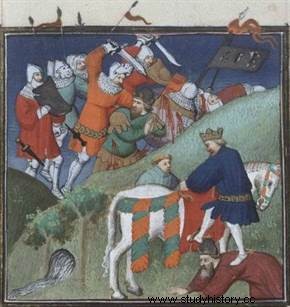 Thanks to the reforms of Heraclius, the empire was able to survive and replenish its military strength despite these territorial losses. In 1014, Basil II (976-1025), known as “the killer of Bulgarians”, defeated the Bulgarians at Balathista, pushing back the borders again to the Danube river. Byzantium was then the greatest power in the Middle East and Europe.
Thanks to the reforms of Heraclius, the empire was able to survive and replenish its military strength despite these territorial losses. In 1014, Basil II (976-1025), known as “the killer of Bulgarians”, defeated the Bulgarians at Balathista, pushing back the borders again to the Danube river. Byzantium was then the greatest power in the Middle East and Europe.
During the 11th century, the Seljuk Turks of Central Asia conquered a large part of the Arab Empire. In 1071, they crushed the Byzantines in the Battle of Manzikert . The occupation of Asia Minor by the Seljuks dealt a terrible blow to the Byzantines. Byzantium had ceased to exist as a great power. In the aftermath of this disaster, Emperor Alexis I Comnenus (1081-1118) appealed to the West to help him recover his lost territories. Pope Urban II responded by urging the faithful Christians of the West to go on a crusade to deliver the Holy Land of Muslim domination.
Byzantium in the tumult of the crusades
Urbain's intervention was surprising. For centuries, the Catholic and Orthodox Churches had drifted apart. Distrust had turned into outright hostility as the two churches vied for influence in Eastern Europe:missionaries from Constantinople had converted Balkan Slavs, Bulgarians and Russians to the Orthodox faith, while the Hungary and Poland had become Catholic. In 1054, the disagreement became permanent after the Pope and the Patriarch of Constantinople mutually excommunicated. The Byzantine emperors considered themselves the legitimate rulers of the territories of the former Western Roman Empire. Southern Italy and Sicily remained within the Byzantine sphere of influence, but it was the place Norman adventurers chose to establish an independent kingdom in the late 11th century.
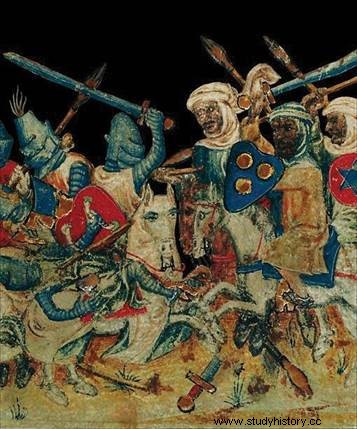 Urbain's call to the First Crusade sparked spiritual fervor among Western Church members . Thousands of knights set out on the long journey to the Holy Land, and in 1099 Jerusalem was taken. Then the relations between Byzantium and the West deteriorated, because after some conquests in Asia Minor, the Byzantines refused to follow the army of the crusaders in Palestine. In the West, many Crusaders were then persuaded that their Greek allies had nothing to do with Christianity. Refusing to return to the Byzantines the territories they had taken from the Seljuks, in Syria and Palestine, they established their own independent states there. The Italian ports of Genoa and \Venice dispossessed the Byzantines of control of trade in the Mediterranean Sea.
Urbain's call to the First Crusade sparked spiritual fervor among Western Church members . Thousands of knights set out on the long journey to the Holy Land, and in 1099 Jerusalem was taken. Then the relations between Byzantium and the West deteriorated, because after some conquests in Asia Minor, the Byzantines refused to follow the army of the crusaders in Palestine. In the West, many Crusaders were then persuaded that their Greek allies had nothing to do with Christianity. Refusing to return to the Byzantines the territories they had taken from the Seljuks, in Syria and Palestine, they established their own independent states there. The Italian ports of Genoa and \Venice dispossessed the Byzantines of control of trade in the Mediterranean Sea.
Further crusades were undertaken to defend the Holy Land against Muslim attacks. After the defeat at Hattin in 1187, the Crusaders lost much territory, including the city of Jerusalem. In 1204, the Fourth Crusade, lacking funds for a campaign in the East, stopped at Constantinople. The crusaders sacked the city and founded a Latin Empire in Greece and the Balkans. Reduced around the Empire of Nicaea , the Byzantines could not reconquer their capital and part of their empire until 1261. Thirty years later, the Turks destroyed the last of the Crusader states in Palestine.
Fall of Constantinople and the legacy of the Byzantine Empire
Weakened by wars, the Byzantine Empire never recovered. The Turks took control of Anatolia in the 14th century, and reduced the empire to an area around Constantinople. The last Byzantine emperors tried to obtain the help of the papacy against the Turks, to whom the Byzantines now paid a heavy tribute. A crusade led by the King of Hungary, Sigismund, failed in 1396. In 1444, the Ottoman sultan Murat II crushed the crusade organized at the call of Pope Eugene IV. The union of Rome and Constantinople, proclaimed in Florence in 1439, came too late. In 1453, without the West intervening, Sultan Mehmet II lays siege to Constantinople, defended by Constantine XI . On the morning of May 29, the capital of the Byzantine Empire fell into the hands of the Ottomans and became their new capital.
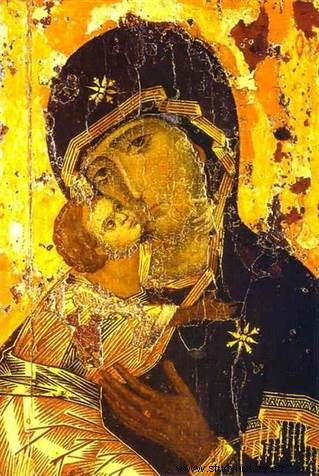 Despite its collapse, the Byzantine Empire left a beautiful legacy. As Western Europe fell into intellectual decline, he continued to observe the cultural traditions of late Roman times . Art, music, literature and architecture were booming The mosaics which decorated its churches were remarkable for their brilliant colors. The story goes that Vladimir of kyiv decided to embrace the Orthodox faith after his ambassador told him that no other religion could bring about a basilica as beautiful as that of Hagia Sophia.
Despite its collapse, the Byzantine Empire left a beautiful legacy. As Western Europe fell into intellectual decline, he continued to observe the cultural traditions of late Roman times . Art, music, literature and architecture were booming The mosaics which decorated its churches were remarkable for their brilliant colors. The story goes that Vladimir of kyiv decided to embrace the Orthodox faith after his ambassador told him that no other religion could bring about a basilica as beautiful as that of Hagia Sophia.
The influence of Byzantine culture spread more widely thanks to the Greek missionaries who converted the Slavs. The Cyrillic alphabet, developed by two brothers, Saint Cyril and Saint Methodius, is the basis of the Russian alphabet and other Slavic alphabets. After the fall of Constantinople, the Russian Grand Prince Ivan III (1462-1505) adopted the Byzantine double-headed eagle as his emblem in 1472.
Byzantine scholars, who visited Italy in the 14th and 15th centuries, exerted a strong influence on the Italian Renaissance . The heritage of the Byzantines, reconnecting with Greek classicism, as much in history, literature, philosophy as in mathematics and astronomy, was transmitted to Italian scholars and to Greeks residing in Italy.
Bibliography
- The Byzantines, by André Ducellier. History Bridges, 1988.
- History of Byzantium, by John Julius Norwich. Tempus, 2002.
- Byzantium - The Eastern Roman Empire, by Jean-Claude Cheynet. Colin, 2015.
